It’s tempting to turn this story into a string of crappy jokes, but the subject is no laughing matter. In Seattle this week, the Bill and Melinda Gates Foundation hosted a two-day “Reinvent the Toilet” fair, attended by scientists and entrepreneurs eager to demonstrate their wares. To put these inventions to a credible test, the Foundation placed an order for about 50 gallons of fake poop. The Gates also offered over $3 million research grants, which were part of a $370 million grant initiative to improve the world’s water, sanitation and hygiene.
According to the Foundation, four out of every ten people around the world have no place “to go.” That adds up to 2.6 billion people without access to a toilet. Poor sanitation results in half the world’s hospitalizations. It is the cause of 2.5 million cases of diarrhea in children under five and 1.5 million child deaths a year, according to a United Nations report. Even in industrialized nations, the amount of water consumed each flush puts pressure on the environment.
In sponsoring this cash competition to come up with a toilet of the future, the Gates Foundation set several requirements. The toilet must operate without running water, electricity or a septic system. It must not discharge pollutants, preferably capture energy or other resources, and operate at a cost of 5 cents a day.
This week’s toilet fair resulted in some very promising solutions, including using soldier fly larvae to process human waste to produce animal feed. Other approaches turn human waste into charcoal and fuel. In announcing the cash prizes for the best designs, Bill Gates said, “If we apply creative thinking to everyday challenges, such as dealing with human waste, we can fix some of the world’s toughest challenges.”
Although coming up with the next toilet isn’t as glamorous as, say, creating the next Eames chair, it shows that design runs deeper than cosmetic solutions.
This video was produced by Loaded Pictures, with illustrations by Jay Bryant.


